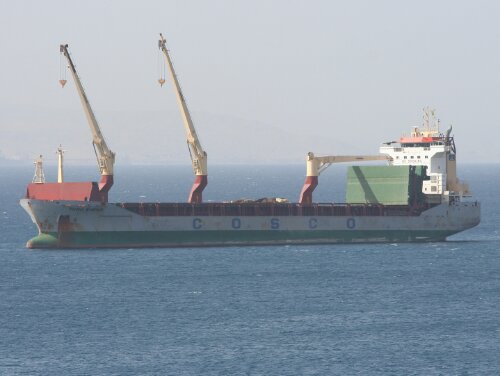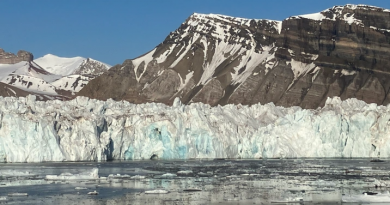All eyes on China as cargo vessel takes to the north

On August 8, the Chinese cargo ship Yong Sheng set sail from Dalian, a port city in northeastern China. The Hong Kong-flagged vessel, owned by Chinese state-owned company Cosco Group, is bound for Rotterdam, in the Netherlands, with its cargo of steel and heavy equipment. But unlike most ships from Asia headed for Europe, Yong Sheng is tacking north, through the Northern Sea Route (NSR).
The Financial Times reports that Yong Sheng is scheduled to reach its destination in only 35 days, on September 11. This would cut off 13 days from the traditional maritime voyage through the Straits of Malacca and the Suez Canal. The NSR promises reductions in journey time of up to 40 percent for vessels leaving from north of Hong Kong compared to the so-called Royal Route. Yong Sheng is currently in the Sea of Japan and most recently docked in Busan, South Korea, showing how other ports in northeast Asia also stand to benefit from increased shipping along the NSR.
Only a few weeks ago, the FT reported that Russia’s Northern Sea Route Administration had authorized 204 ships to make the crossing this year. But now, the British newspaper notes that 372 ships have received authorization – a near doubling. A check of the NSR Administration’s website today reveals that 421 ships have now received permits, meaning the folks at the Moscow headquarters have been working overtime in the past month to issue 217 new permits.
It’s clear that a great many more ships will be sailing through the NSR this year than the year before. So with a possible 421 ships slated to make the journey, many of them with the mandated assistance of Russian icebreakers, why is the media jumping on the story of Yong Sheng?
For starters, it’s China’s first commercial ship to sail the NSR. The Guardian proclaims that the ship is undertaking one of the
“most audacious voyages of modern seafaring.” But although the route is still dangerous, this is no longer the eighteenth century filled with foolhardy, underprepared explorers. The Yong Sheng isn’t even the first cargo ship to tackle the NSR: other countries, including Asian ones such as Japan and Korea, have previously sent them along the route. Many have been liquefied natural gas (LNG) tankers (an arguably more precarious cargo), while some have carried goods like heavy machinery. One possible issue with the commercial viability of the NSR is that the main westbound exports would require cargo ships, while the primary eastbound exports from places like Norway and Russia would require different types of vessels, namely LNG tankers. This means that ships might have to travel empty in one direction, which is not a terribly exciting prospect for shipping companies.
The second reason that newspapers are providing ample coverage of Yong Sheng’s journey is because it’s a Chinese vessel. Last summer, the same papers were reporting excitedly (and perhaps somewhat unnervedly) on the Arctic voyage of the Xiao Long, or Snow Dragon – China’s sole icebreaker. Less fuss is made about Korean or Japanese voyages to the Arctic, whether by their icebreakers or commercial ships. The FT article on the Yong Sheng concludes with,
“China, which claims to be a “near-Arctic state”, has become more aggressive in asserting its interests in the northern Pacific and Arctic oceans. In May, Beijing secured “permanent observer” status at the Arctic Council, a group uniting the eight countries with territory in the polar region.”
The second sentence seems to be a non-sequitur, as China, along with Japan, Korea, India, Singapore, and the European Union, applied for Arctic Council (AC) observer status in a legitimate manner, and it was the AC permanent member states that decided, by consensus, to grant all of them* the status – China included. Thus, it’s not clear how observer status is connected to assertive behavior in the Arctic.
Moreover, let’s not forget that the UK calls itself a “sub-Arctic state” and British adventurers and scientists alike regularly make journeys to the Antarctic and Arctic without arousing comments that the country is acting “aggressively” or “assertively.”
So while Yong Sheng’s voyage is notable in that it’s China’s first commercial transit of the NSR, at the end of the day, it’s only one voyage out of hundreds. A more important voyage to happen this month might be the one currently underway by the International Maritime Organization’s (IMO) Secretary-General, Koji Sekimizu, who hails from Japan. Sekimizu is sailing on the Russian icebreaker, 50 Let Pobedy, for five days on a fact-finding mission that will take him from Dikson, in the Kara Sea, east to the East Siberian Sea. The specialist publication Maritime Executive has an excellent article on the details of Sekimizu’s trip. Representatives from the Russian government will be on onboard, and Sekimizu will discuss everything from climate change to NSR infrastructure to UNCLOS with them.

The IMO voyage is perhaps more important than that of the Yong Sheng because the outcome could affect the organization’s work on creating the Polar Code, which has now been in the works for years. Furthermore, years ago, Japan expressed interest in working with the United States to help develop the rules for northern shipping. Now, with Sekimizu at the helm of the IMO, Japan will surely have a hand in shaping the much-needed Polar Code. In a way, Japan could then assert its interests in Arctic shipping, albeit in a wholly diplomatic manner. Yet little is made of the fact that a Japanese man heads up the IMO, the most important multilateral body related to shipping. No newspapers worry that Japan is acting “aggressively” in the Arctic. One can only imagine the attention Sekimizu’s voyage might have garnered had the Secretary-General hailed from China instead.
*The EU has technically been admitted, but full observer status hinges on it ironing out a dispute with Canada over the union’s ban on seal fur imports.



